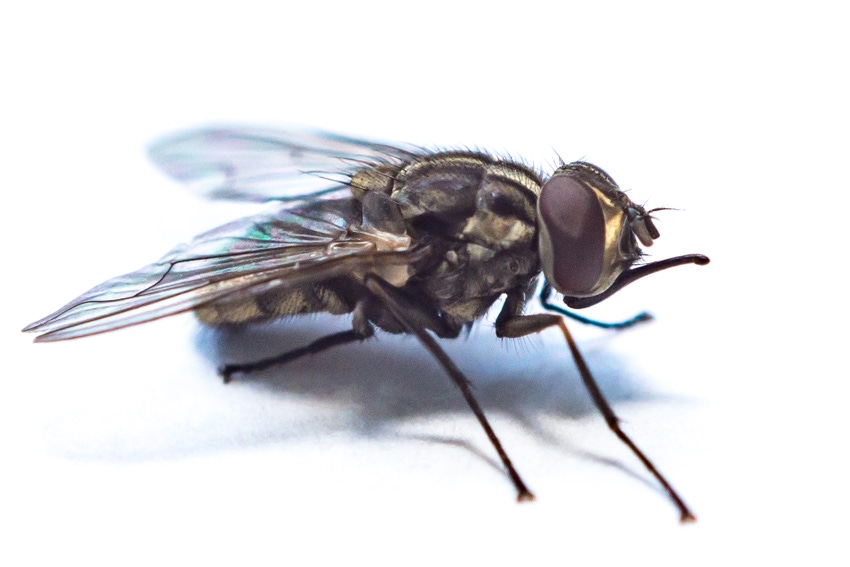Stable fly potentially dangerous disease vector for pigs
Stable flies found to be carriers of several bacteria types and possibly also serve as vectors for PCV2 and mycoplasma.
October 16, 2020

The common biting fly (Stomoxys calcitrans), also known as the stable fly, is widespread worldwide and looks similar to the house fly but has a proboscis through which it sucks blood. During this blood meal, it can transmit diseases to its host animals. A study by the University of Veterinary Medicine (Vetmeduni) in Vienna, Austria, examined the extent to which pigs are endangered by the biting fly.
The biting fly can often be found in animal stalls, Vetmeduni said, and the blood-sucking insect is anything but harmless, as it has direct and indirect negative consequences for animal health. Direct influences can be, for example, restlessness, pain from stinging, stress, blood loss and reduced feed consumption, but also skin lesions with resulting local inflammation and immunosuppression, while indirect effects can be traced back to the transmission of infectious agents, the announcement said.
For host species such as horses, biting flies are known to be relevant vectors for the transmission of infectious diseases, but so far only a few studies have been carried out on pigs.
Vector of numerous microorganisms
To find out more about the possible role of biting flies in the transmission of pathogens, a research team led by Lukas Schwarz from the University Clinic for Pigs at Vetmeduni Vienna investigated, as part of a diploma thesis, biting flies from Austrian pig farms on pig pathogens such as porcine reproductive and respiratory syndrome virus (PRRSV), porcine circovirus-2 (PCV2), hemotrophic mycoplasmas and cultivatable bacterial pathogens, the university said.
In addition, the researchers examined the biting flies in their pilot study with regard to their possible use as a diagnostic matrix for the detection of pathogens in the pig blood they had ingested.
“In total, we found 69 different types of microorganisms on the surface of S. calcitrans from 20 different pig farms. Escherichia coli was the most common type of bacteria and was found in biting flies from seven farms. Hemotrophic mycoplasmas were also detected in seven farms. PRRSV could not be found in any of the samples, but PCV2 was detected in six companies,” Schwarz said.
Underestimated carrier of disease
The results of the study suggest that stable flies in Austrian pig farms are carriers of several different types of bacteria and possibly also serve as vectors for PCV2 and hemotrophic mycoplasma.
Schwarz said more attention should be paid to the stable fly and its role as a disease vector in pigs. “Although we have not yet been able to conclusively assess the explicit role of S. calcitrans as a vector, we are of the opinion that the role of biting flies is in the transmission of diseases and pathogens in pigs is underestimated in Austria," he said.
Potential diagnostic method
In addition, the researchers are considering using stable flies as a diagnostic matrix for the detection of PCV2 and hemotrophic mycoplasma in the future. According to Schwarz, however, further studies are necessary for validation and to clarify whether the stable fly could also be used as a diagnostic matrix for tests for PRRSV.
In addition, the use of stable flies to monitor herd health would be an inexpensive and animal-friendly alternative to blood collection or other invasive collection techniques in pigs, he added.
S. calcitrans is one of 18 species belonging to the genus Stomoxys and is most common in temperate climates. The 7-8 mm fly is gray and has four dark longitudinal stripes on the thorax. In contrast to the large housefly (Musca domestica) — the dominant fly species in the pig operations — the stable fly has a shorter and wider abdomen.
The stable fly prefers moist straw, manure and old litter as a breeding substrate and does not lay its eggs in pure excrement, Vetmeduni said. Stable flies are often found in the stables of ruminants and horses, but also in pig barns, and their stings can cause considerable economic losses in livestock farming.
The article, "The Stable Fly (Stomoxys calcitrans) as a Possible Vector Transmitting pathogen in Austrian Pig Farms," by Luke Black, Andrew Strauss, Igor Loncaric, Joachim Spergser, Angelika Auer, Till Rümenapf and Andrea Ladinig was published in microorganisms.
You May Also Like



